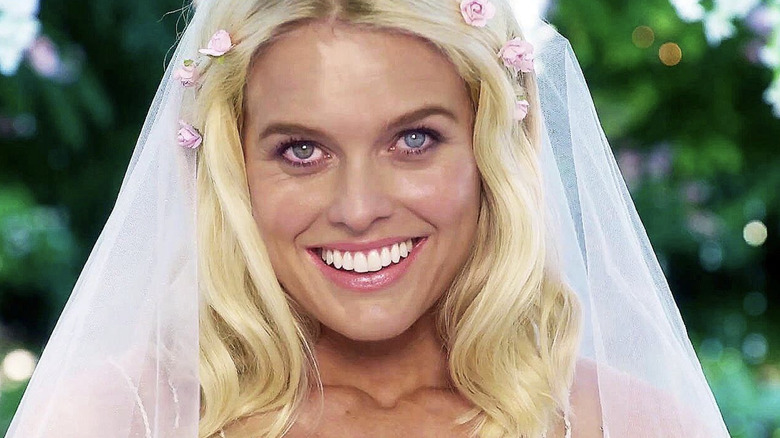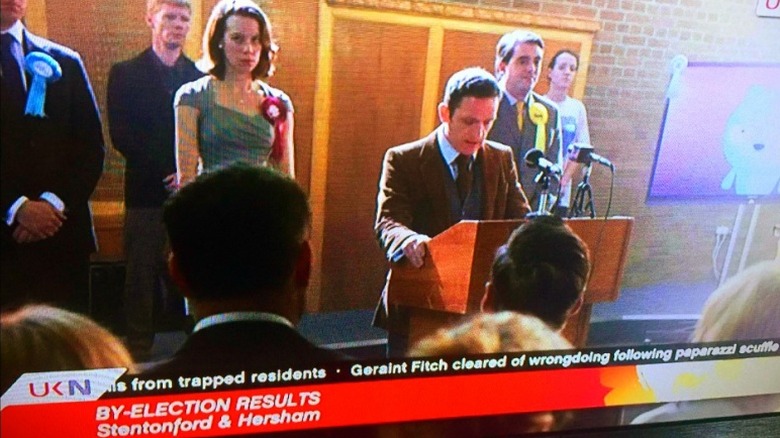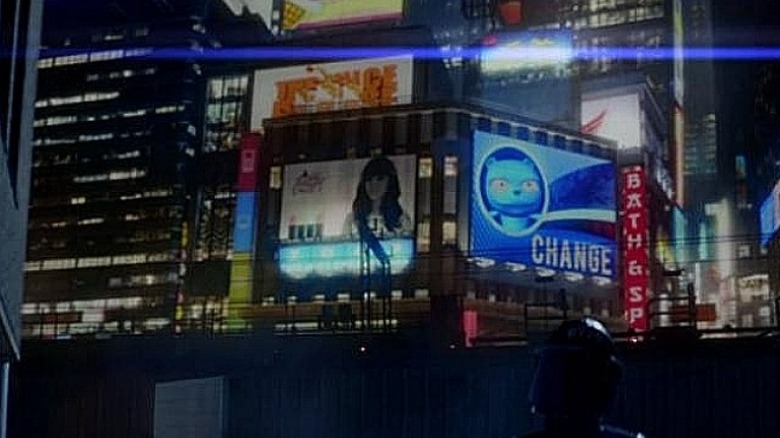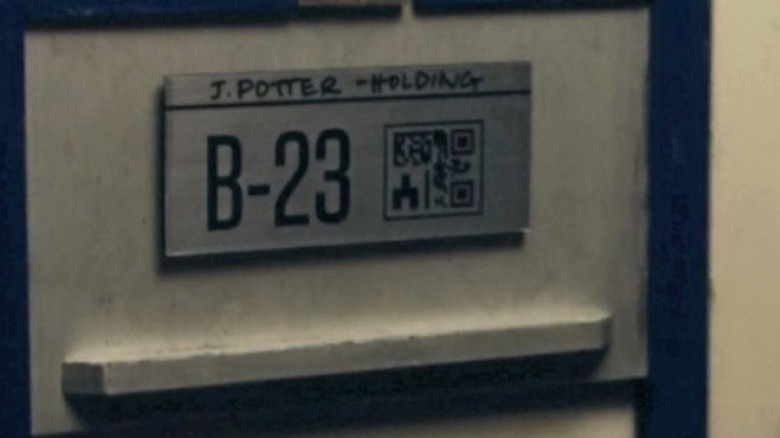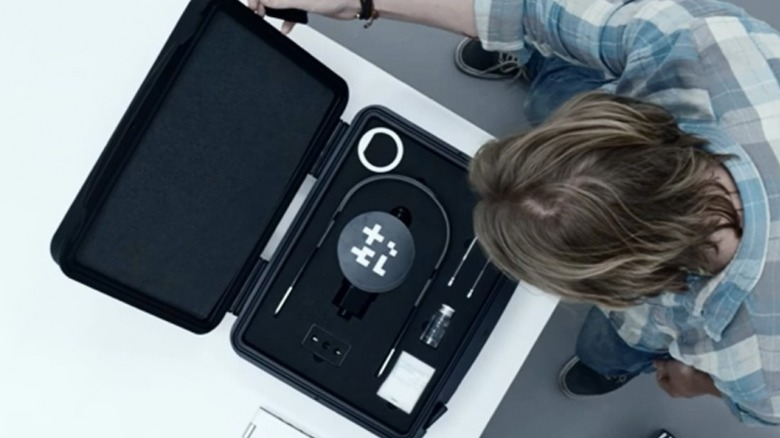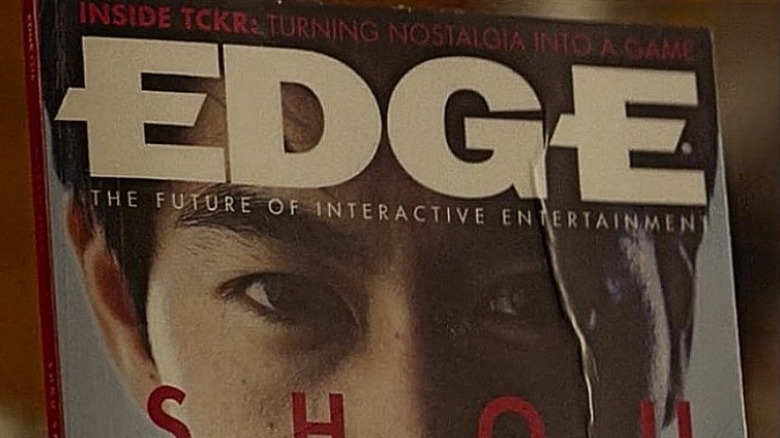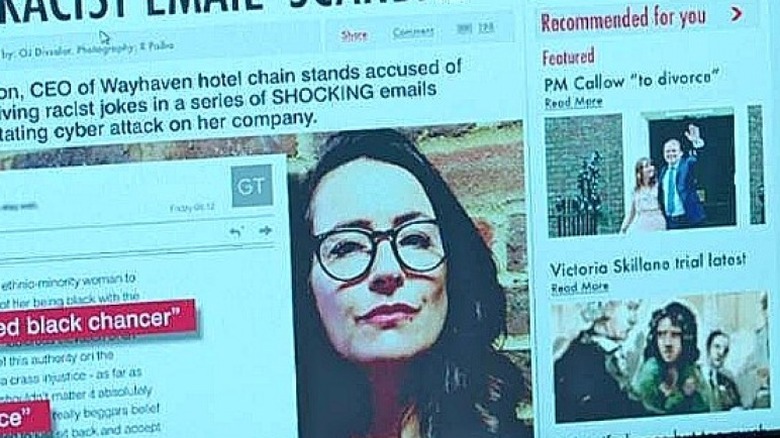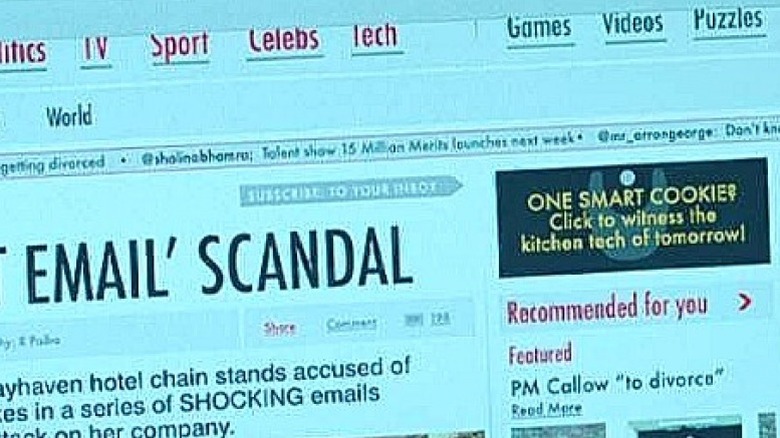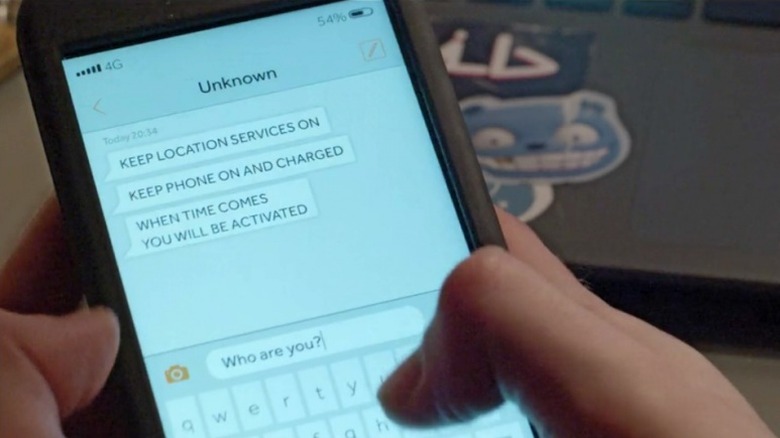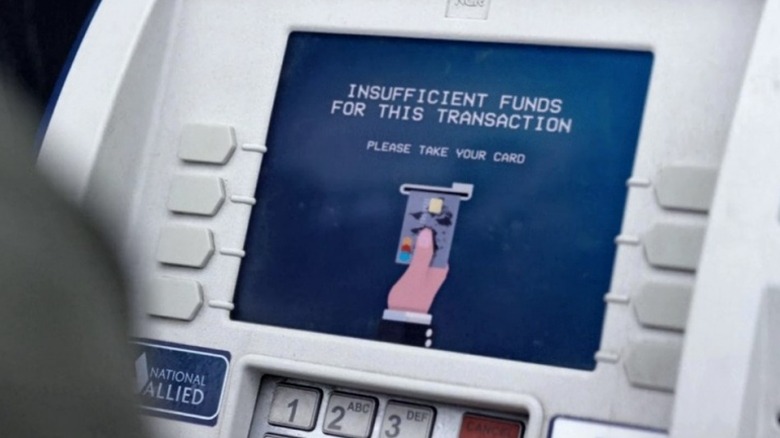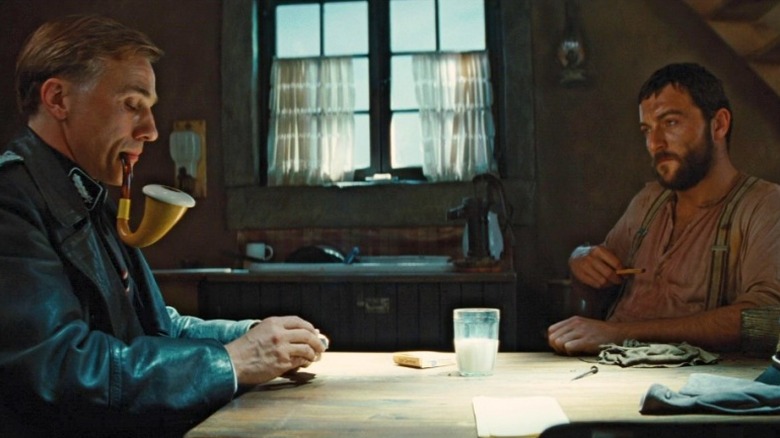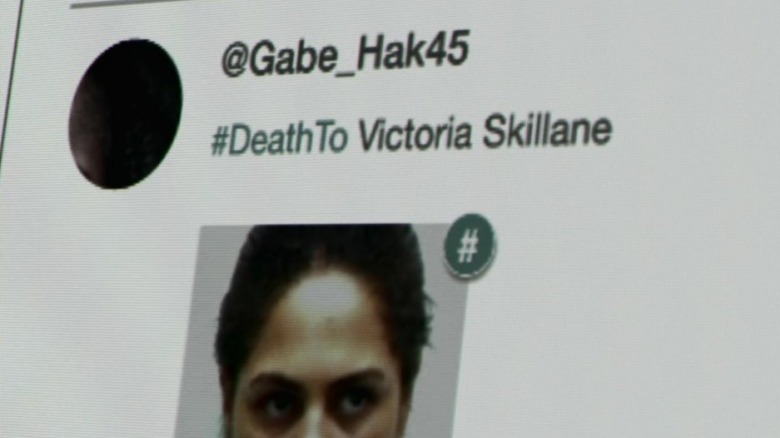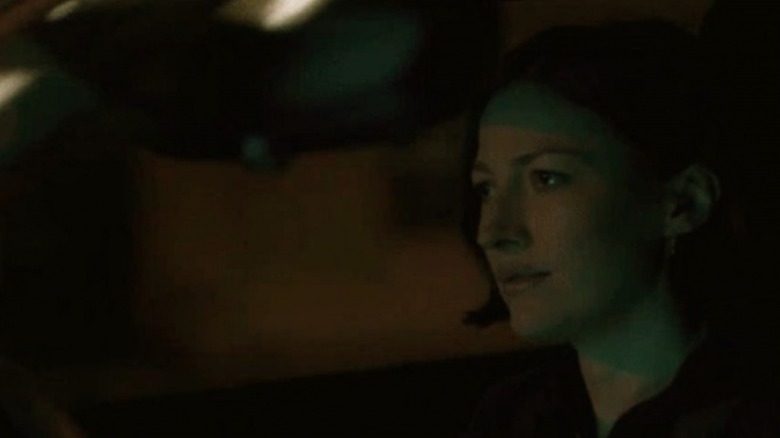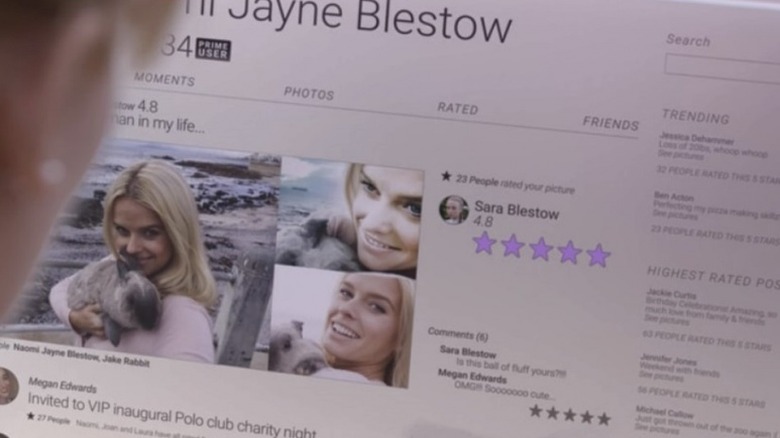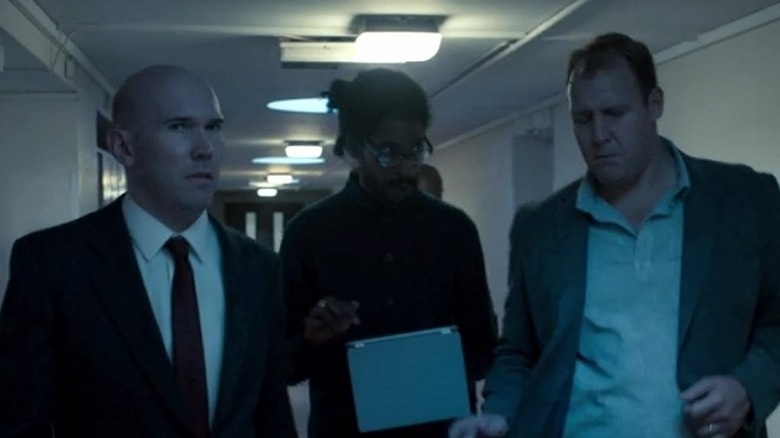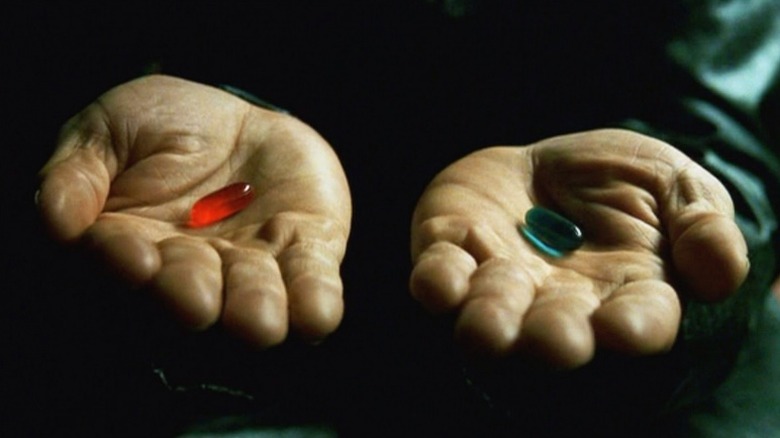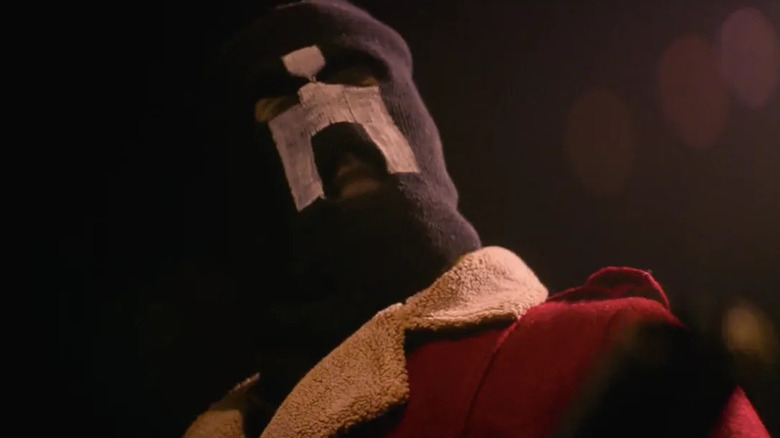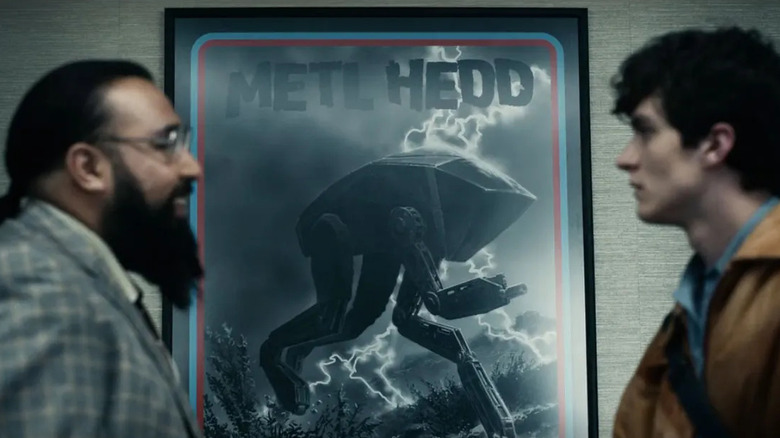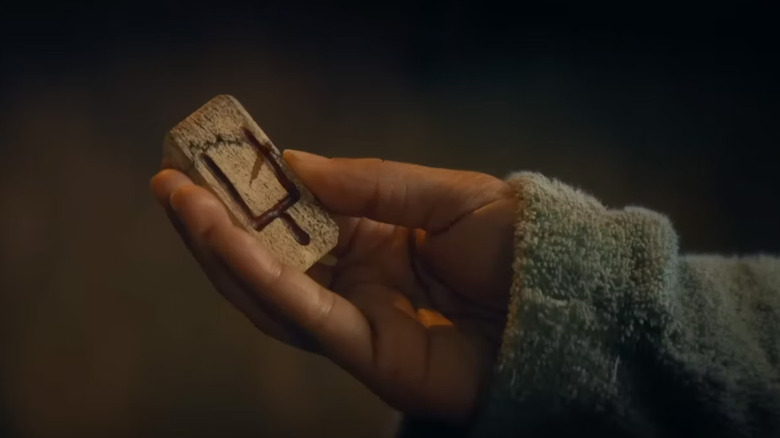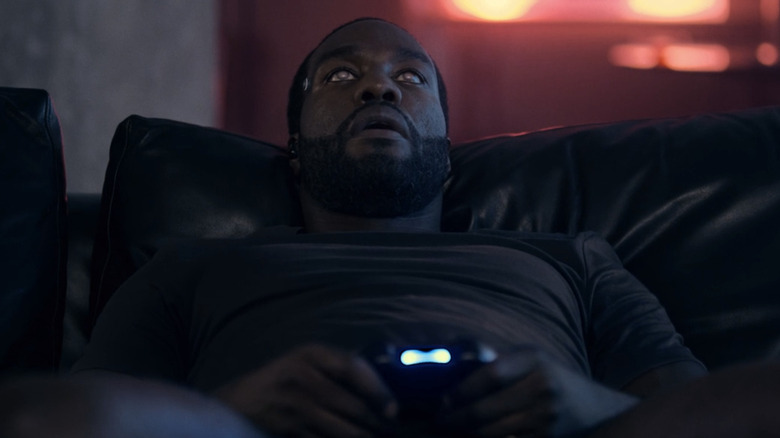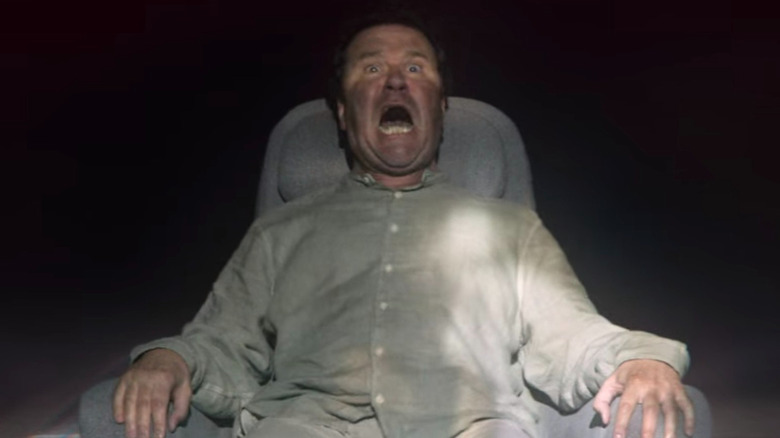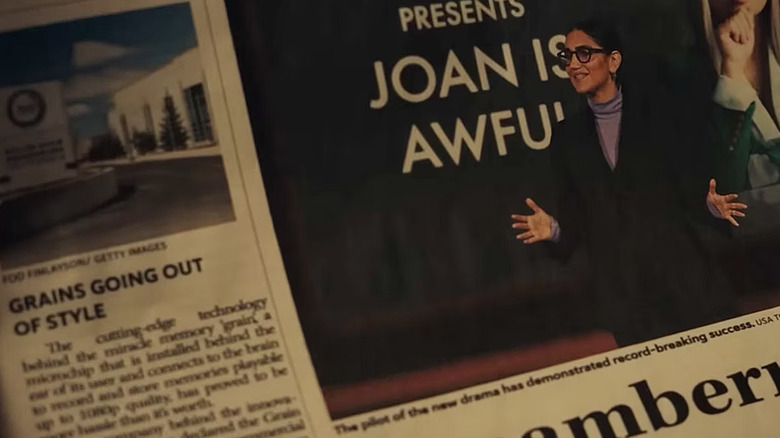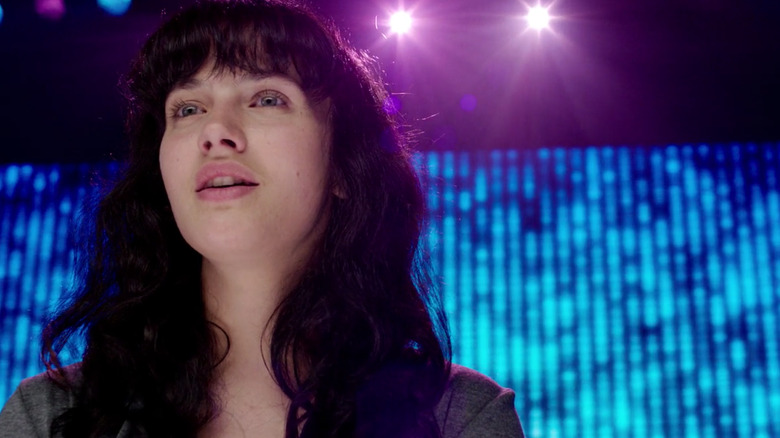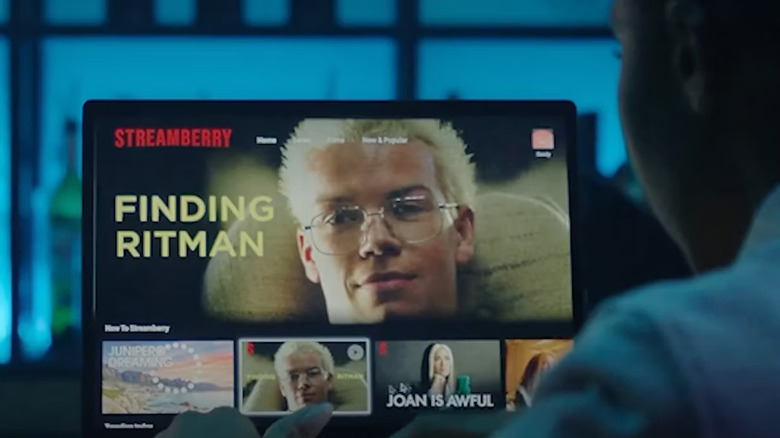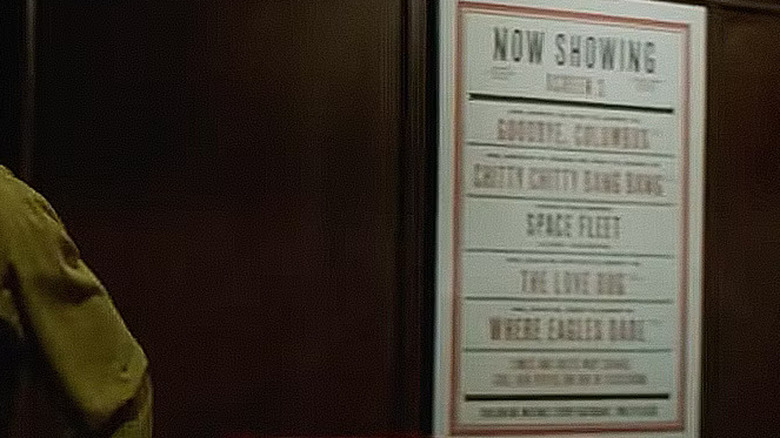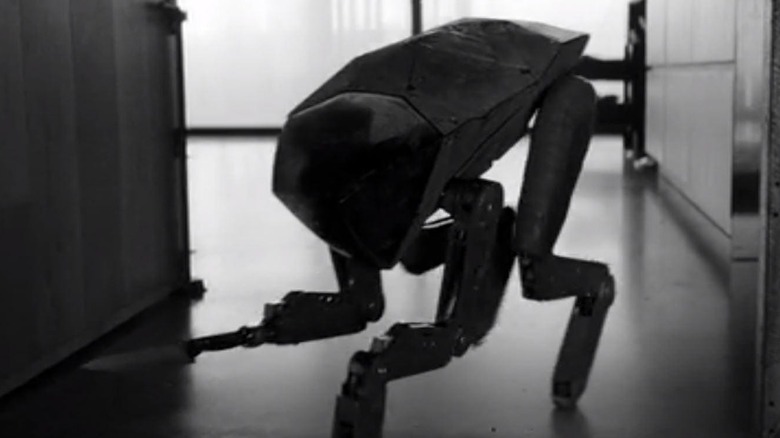Black Mirror Easter Eggs You Didn't Notice
Since its arrival in 2011, "Black Mirror" has been a key part of the diet for any discerning fan of modern horror and science-fiction. With its simultaneously thought-provoking and stomach-churning writing, series creator Charlie Brooker has truly captured lightning in a bottle. The series, with limited exception, is an anthology exploring the evil nature of technology, and people, through often tragic circumstances.
From cyclical public torture to virtual mind prisons to exercise bike-based futures, the series has a little bit of everything. "Black Mirror" is also a show for those who enjoy the concept of a shared universe, something Marvel has made quite popular. Despite the ever-changing themes and shifting tones presented in each episode, the show is littered with dozens of nifty little Easter eggs. Whether it's an overt callback or a brief visual reference, these are the ones that most effectively made an impact. So, fire up your Grain and install some anti-virus software, because these are some "Black Mirror" Easter eggs you may have overlooked.
Paparazzi scuffle (The Waldo Moment)
"Black Mirror" Easter eggs first began appearing in the last episode of the second season, the story of a failed comedian whose character (a blue cartoon bear named Waldo whom the comic controls with motion-capture technology) accidentally ends up becoming the face of global movement after a talk show outburst. "The Waldo Moment" harks back to the first "Mirror" episode, "The National Anthem," infamous for the scene in which Prime Minister Michael Callow has sex with a pig live on television in order to save the life of a kidnapped royal.
Naturally, both episodes feature a lot of news reports, and "The Waldo Moment" marked the first time fictional network UKN reappeared — the channel that beamed Pig-gate across the nation and around the world. Look a little closer, and you'll notice both episodes also feature the same news bulletin declaring that a man named Geraint Fitch has been "cleared of wrongdoing following paparazzi scuffle."
Abi Khan advert (The Waldo Moment)
"The Waldo Moment" also contains an Easter egg linking it with "Fifteen Million Merits," a Black Mirror attack on TV talent shows. This Season 1 episode takes place in a world in which obese people are routinely ridiculed and the fit constantly exercise in exchange for Merits — 15 million of which are needed to make an appearance on "Hot Shots," a television show that gives people the chance to prove themselves as a performer and leave their monotonous lives behind for stardom.
After a sizable Merit donation from a friend, Abi Khan (Jessica Brown Findlay) gets her chance to show off her singing in front of the judges and a live audience, though she, like many before her, is told that her voice is average and is instead offered a spot on a pornographic TV station. Having been unwittingly drugged before her performance, a confused Abi agrees, and her picture goes on to appear on billboards... right next to Waldo.
Advertising guy (White Christmas)
"Black Mirror" fans received an unexpected festive treat in 2014 in the form of near-feature length Christmas special "White Christmas." The episode stars Jon Hamm opposite Rafe Spall and Oona Chaplin in three intertwining stories of technology gone awry, and Easter eggs pop up in the very first conversation.
Hamm, of course, rose to prominence playing chain-smoking advertising executive Don Draper in AMC's long running hit "Mad Men," and his character here has a past that is arguably even murkier than that of Draper. Before the short stories begin, Hamm and Spall are introduced to viewers as two barely acquainted men, stationed together at a remote outpost in the middle of a snowy wilderness, forced to eke conversation out of each other over an awkward Christmas drink. As part of their icebreaker, Hamm asks his colleague to guess what he thinks his last job was, to which he replies "advertising guy."
White Bear logo (White Christmas)
The Christmas special also made a number of references to prior seasons. Spall's character flicks past an advert for "Hot Shots" at one point, a karaoke scene features the same song that Abi performed on the underhanded talent show ("Anyone Who Knows What Love Is"), and one of Hamm's online cohorts goes by the screen name Pie Ape, which was "Fifteen Million Merits" slang for a fat person. This wasn't the only episode it offered multiple nods to, however.
There are several links to controversial Season 2 episode "White Bear" jammed in there as well — some, previously uncovered by the fanbase, others not. Fictional news network UKN is back, a goldmine for Easter eggs that didn't disappoint on this occasion, informing viewers that child murderer Victoria Skillane's appeal had been rejected with a quick newsflash. There's also a tiny "White Bear" logo hidden away in Spall's cell at the very end of the episode.
White Bear logo (Playtest)
This mysterious symbol pops up once again in standout Season 3 episode "Playtest," the story of an American backpacker named Cooper (Wyatt Russell) who runs out of money on the European leg of his round-the-world trip and, in need of a quick buck, decides to take part in a test run of a new virtual reality horror game at a site just outside of London.
Cooper is given the inside track on the gaming company by British hook-up Sonja (Hannah John-Kamen, the same actress that played Selma in "Fifteen Million Merits") who happens to be a game nut, but when he gets there he encounters something even she has never seen before. The same symbol that appears on the mask of the armed hunter throughout "White Bear" can be seen on one of the discs that later turn to gopher holes as part of the whack-a-mole style warm-up game.
Turning nostalgia into a game (Playtest)
Before Cooper sets off for the countryside headquarters of SaitoGemu in search of some quick cash to fund his flight home, Sonja shows him a copy of "EDGE" magazine with the gaming company's founder, Shou Saito, on the cover. Easter egg hunters were quick to point out the block of text located in the bottom corner of the page that advertises an article about Granular, the company behind the AI bees that run amok in season 3 finale "Hated in the Nation," though the cover makes reference to another episode from the latest series.
The ad at the top of the page reads "Inside TCKR: Turning Nostalgia Into A Game," which means this issue of "EDGE" (a genuine UK gamer's mag) also contains an article about the company behind "San Junipero." This virtual reality system, featured in the episode of the same name, allows the consciousness of the dead to be uploaded to a cloud, where they can live as their young selves in whichever year they please.
Victoria Skillane trial latest (Shut Up and Dance)
Season 3's "Shut Up and Dance" follows the plight of 19-year-old Kenny after malicious hackers use his webcam to record him masturbating and then blackmail the teen into committing a bank robbery alongside a cheating husband, caught red-handed with a prostitute by the same hackers. While the reason for his intense panic becomes clear with a dark twist, Kenny accessing child pornography isn't the only revelation in this episode, which is rife with Easter eggs.
When the racist CEO (another victim of the hackers) opens a webpage to a story about her leaked private emails, shamed former Prime Minister Michael Callow can be seen quite clearly in the side column as part of a story announcing his divorce. That one was easy enough to spot, but just below him is a courtroom sketch of Victoria Skillane, the woman from Season 2's "White Bear," who has her memory wiped nightly and is forced to relive a single day indefinitely as punishment for her crime.
Cookies and credits (Shut Up and Dance)
Sticking with the article on the racist CEO but moving towards the top of the page, there's an Easter egg that references holiday special "White Christmas" in the form of a cryptic advertisement reading "ONE SMART COOKIE? Click to witness the kitchen tech of tomorrow."
The tech it refers to is, of course, the Cookie, a device which holds a trapped copy of your own consciousness and forces that sentient copy to tend to your every need, uniquely qualified as a personal slave. That was certainly one of the more subtle Easter eggs hidden in Season 3, but those willing to go over the show with a fine-toothed comb have found yet another reference to a past episode on this mocked-up webpage. Above the Cookie ad in small, barely noticeable type is a notification that harkens back to a classic Season 1 episode that parodied the impact of shows like "American Idol" and "The X-Factor": "Talent show '15 Million Merits' launches next week."
Waldo sticker (Shut Up and Dance)
After threatening to send the video to everyone he knows, Kenny's invisible tormentors convince him to embark on a wild goose chase that begins with the delivery of a cake and ends with a fight to the death against another man caught doing something he shouldn't have been. Before he gets to this point and finally realizes the enormity of the situation, Kenny receives a series of text messages from an unknown number, demanding that he keep his location visible and his phone charged so he can be "activated" when the time comes.
These messages arrive shortly after an email confirming the hack with the incriminating video attached, and the viewer is as eager to see what the people behind it have to say as Kenny; tear your eyes away from the texts, however, and you'll notice a familiar face peering around the phone. The mocking grin of cartoon bear-turned-political weapon Waldo can be seen on Kenny's laptop.
National Allied bank (Shut Up and Dance)
Kenny's bank robbery was one of the most memorable moments from the third season, brilliantly acted by Alex Lawther and his partner in crime Jerome Flynn (Bronn from "Game of Thrones") from the moment the hapless duo pulled up outside a branch of fictional British bank National Allied with little time to lose. The first thing noticeable about the bank is its rural location, and the second thing is the logo. That's when viewers can put two and two together and realize that this bank also has branches in the city, because it was one of their London cash machines that failed to dispense Cooper's flight money in "Playtest."
The slanted V-shaped logo (slightly obscured by Cooper's shoulder at the ATM) also looks very similar to those emblazoned on military uniforms in "Men Against Fire," which is either commentary on banks and their history of profiting from war, or merely a strange coincidence.
The roach hunter (Men Against Fire)
In his year end review "Charlie Brooker's 2015 Wipe," the "Black Mirror" creator bemoaned the way certain sections of the UK media handled the immigration crisis throughout the year, with many news outlets referring to those seeking asylum from war and persecution in Iraq, Syria and beyond as a "swarm of migrants," dehumanizing them in the eyes of the British public and making their plight easier to ignore. This certainly seems to have been the inspiration behind "Men Against Fire," in which soldiers in the near-future are given an implant that allows them to see their enemies (whom they call Roaches) as monsters instead of humans, making them easier to kill.
Director Jakob Verbruggen clearly had influences of his own, and one of them appears to have been Quentin Tarantino's WWII epic "Inglourious Basterds." As young soldier Stripe goes out on his first Roach hunt, his superior interviews a man in his kitchen about hiding Roaches from the military, echoing the opening moments of Tarantino's film, in which "Jew Hunter" Hans Landa (Christoph Waltz) interrogates a French farmer harboring enemies of the Führer beneath his floorboards. The two scenes are remarkably similar, from the angles and lighting to the interviewee's bushy beard. Even the monologues are similar; to top it off, the scene ends in the same way — with all Roaches/Jews killed, except for one girl who escapes on foot.
Trending on Twitter (Hated in the Nation)
The implants that allow the soldiers to kill in cold blood in "Men Against Fire" are part of what is referred to as the MASS Project, and it isn't the only time it gets a mention in the third season. During series closer "Hated in the Nation," policewoman Karin Parke (Kelly Macdonald) watches a UKN news report on the troubled Chancellor, and along the bottom of the screen runs a headline announcing the US military's approval of the MASS Project. This is just one of many previous episode Easter eggs begging to be noticed in "Hated in the Nation," the feature-length Season 3 finale that references a total of seven "Mirror" episodes in some shape or form.
The story follows two female detectives as they unearth a madman's plot to hack the government's artificially intelligent flower pollinating bees and use them to kill a person a day, with targets chosen via a public vote. These votes are cast using #DeathTo followed by the name of the person you want dead, and over the course of the episode a number of other hashtags appear on screen. One user wishes for #DeathTo Victoria Skillane while another wants to #FreeTheWhiteBearOne. #MASS is trending at one stage, as well as #SaituGamu, the gaming company from "Playtest" who are also revealed to be under investigation over the disappearance of a tourist on a UKN snippet.
Blue worked on the Rannoch case (Hated in the Nation)
While Brooker has quashed rumors that every single "Mirror" episode is connected in some way, he did admit to some "explicit links" between some of the stories during a Reddit AMA. The one he gave as an example was that Karin's partner Blue Coulson (Faye Marsay) in "Hated in the Nation" transferred to the field from the cyber forensics department after personally discovering pictures of Ian Rannoch's victims. Rannoch is the boyfriend of "White Bear" child killer Victoria Skillane, and we know from that episode that the pair abducted and murdered at least one child together, though from Blue's description of his "child killings" it appears he murdered more than once.
Updates on Skillane herself are scattered throughout "Hated in the Nation," and not just on Twitter. "Black Mirror" network of choice UKN is covering the "White Bear" case extensively, with one update revealing that her appeal has been thrown out of court and another announcing a failed suicide attempt.
Callow thrown out of zoo (Nosedive)
Another nod to the first "Mirror" episode "The National Anthem" is hidden within the Season 3 opener "Nosedive," a pastel-hued social media satire starring Bryce Dallas Howard as Lacie Pound, a social climber desperately trying to up her rating on a popularity platform seemingly embraced by Americans nationwide. People are judged by their score, which is ranked using a five-star system. Both strangers and friends can affect your star rating at the touch of a button, and Lacie is constantly scrolling through her friends' profiles in the hope of scoring points and reaching her desired social ranking of a mid-4.
Those with a sharp eye will notice that as Lacie visits the profile of her 4.8 friend Naomi Jayne Blestow (Alice Eve), a status update from one Michael Callow pops up in the bottom right-hand corner of the shot. Callow writes that he "just got thrown out of the zoo again," adding a sad face to emphasize his disappointment.
Sea of Tranquility (Nosedive)
Lacie's chance to score some serious popularity points comes when an old friend unexpectedly asks her to be maid of honor at her wedding, an event which will be full of influential high-4 people to mingle with. If she doesn't reach a rating of 4.5 soon, she won't be permitted to move into a house on an exclusive estate for the popular.
After an airport argument leaves her with too poor a score to board her plane, Lacie is forced to take a budget rental car, and when that breaks down her last hope is hitching a ride on a bus with fans of a show named "Sea of Tranquility." Described as an "HBO Moon Western," this show was mentioned in the first-ever "Black Mirror" episode, as its dreadlocked special effects designer is hired in secret to come up with a digital solution to the Prime Minister's impending date with a pig.
The blue flask or the red flask (Novedive)
Stephen King has described "Mirror" as "like 'The Twilight Zone,' only rated R," and the similarities between the two anthologies are there for all to see, but there are some nods to more modern sci-fi classics in there, as well. After Lacie's popularity rating drops to a near-unsalvageable low, she meets a trucker who's been ignoring the system put in place by this invisible social media platform and living as she pleases.
After reluctantly accepting a ride, Lacie listens to the trucker's argument for breaking away from the imposed system. She's then offered a drink by the wise outsider — coffee (in a blue flask) or whiskey (in a red one). This is a subtle nod to the now-iconic blue pill/red pill scene from "The Matrix," with the coffee representing Lacie's decision not to stray out of character and the whiskey an opportunity to abandon that character for good.
The items in the Black Museum (Black Museum)
The fourth season of "Black Mirror" reached its crescendo in its final episode, the superbly warped anthology episode titled "Black Museum." The episode can almost be viewed as a microcosm of the series itself, as it opts to tell a few shorter stories, each contributing to a greater narrative.
Viewers meet Nish (Letitia Wright), a driver who stops off to visit the titular Black Museum, a roadside attraction run by Rolo Haynes (Douglas Hodge). The place appears to be a true crime museum of sorts, with all the items on display having been lifted from actual crime scenes. This provides the episode not only with its framing device, but also the perfect excuse for a barrage of series callbacks and Easter eggs.
Most come via quick little shots of items which played a key role in the events of past episodes. Sharp-eyed viewers can spot the suit and mask that one of the White Bear Justice Park employees was wearing in "White Bear," complete with the mysterious and frequently reappearing symbol. A little later, the DNA scanner from "USS Callister," used by Robert Daly (Jesse Plemons) to create his twisted Space Fleet fantasy world, appears as well. There's also the (still bloodstained) bathtub from the horrific finale of "Crocodile," as well as the smashed Arkangel tablet from "Arkangel." Look for the outfit worn by Carlton Bloom, the kidnapper from "The National Anthem," in the background as well.
Tuckersoft's other games (Bandersnatch)
In-between the fourth and fifth seasons, Brooker took the series in a new direction, that of a one-shot interactive film. Inspired by classic "Choose Your Own Adventure" books, "Bandersnatch" shows the interactive narrative taken to its most logical and disturbing conclusion. The episode follows Stefan (Fionn Whitehead), a burgeoning programmer whose sanity is stretched to the limit while he codes an adaptation of the fictitious novel "Bandersnatch" for Tuckersoft.
Tuckersoft is where Stefan meets Colin Ritman (Will Poulter), another game designer who has already seen ample success. During the scenes at Tuckersoft, eagle-eyed fans will likely catch some nods to past "Black Mirror" episodes in the form of the company's other games. In the background, you can see the poster for a game titled "Metl Hedd," a game that appears to feature deadly robotic dogs as the main enemy. This is an overt reference to a previous episode titled "Metalhead," a story that concerns an apocalyptic future overrun by murderous robotic dogs. Viewers can also see the latest project that Ritman is coding, a video game titled "Nohzdyve, which is a nod to the episode "Nosedive."
The White Bear symbol is back (Bandersnatch, Beyond the Sea, Demon 79)
The symbol first shown in the episode "White Bear" has become something of a recurring motif throughout the show's still-ongoing run. The symbol — an upside down letter Y — was first seen on the television by Victoria Skillane after waking up during one of her torture sessions at White Bear Justice Park.
Following this one-off usage, the symbol has continuously popped up throughout subsequent episodes, as a bit of nifty world building. The symbol itself took on a slightly different meaning when it popped up again in "Bandersnatch," the interactive episode. Here, the symbol was used to represent the branching paths created when the viewer makes a choice for Stefan throughout the story.
The symbol hasn't stopped its streak of appearances, as it popped up yet again in the show's most recent crop of episodes. There's a glimpse of it early on in "Beyond the Sea," following the brutal murder of the duplicate of David (Josh Hartnett) and his entire family. The disturbing sequence is capped off with a shot of the cult smearing the symbol on the walls in the blood of David's family. The symbol also appears in "Demon 79," on a ruin used by Nida (Anjana Vasan) to summon a demonic entity known as Gaap. Regardless of where and how it appears in the "Black Mirror" timeline, disaster and devastation seems forever linked to the ominous little emblem.
The VR device (Striking Vipers)
Given the overarching theme of technology running throughout "Black Mirror," it shouldn't come as a shock that there have been ample callbacks. In this case, devices and tools introduced in one episode could very easily appear in another, albeit in a much different context. Such is the case for the virtual reality device that was first introduced in the events of "USS Callister."
The "Star Trek"-inspired episode saw Robert Daly, the chief technical officer for a video game company, use the device for nefarious purposes. The device, meant to be attached to the user's left or right temple, is about the size of a shirt button. When activated, the device both disables the user's ability to move in the real world while immersing their mind in a fully virtual experience. Viewers see the horrifying implications of this technology when, at the episode's conclusion, Daly is trapped in a dark virtual void, unable to move in the real world.
This technology then resurfaced during the events of "Striking Vipers," when used by Danny and Karl during their virtual sex-capades. It's a perfect example of an element introduced in one episode then being used for a similar-yet-different purpose in an entirely different one.
Rolo Haynes' final fate (Rachel, Jack and Ashley Too)
Throughout the disturbing events of "Black Museum," a very clear picture is painted of who exactly is Rolo Haynes. As Haynes regales Nish with his stories of technological crimes, it becomes clear that Haynes is a legitimate monster. It seems his dealings in the world of tech, specifically an illegal monkey toy, resulted in his termination and his founding of the Black Museum.
Viewers also see what serves as the museum's main attraction, a holographic preservation of a convicted murderer named Clayton Leigh. It seems many were willing to pay a pretty penny in order to relive the electrocution of a murderer, something Haynes was happy to cash in on. But Haynes soon realizes he's been poisoned and the culprit is none other than Nish, who then reveals herself as Leigh's daughter.
Seeking revenge for what Haynes has turned her father into, she proceeds to put Haynes in his spot and cranks the voltage up to the maximum, killing him. Nish then sets the Black Museum on fire, an event later referenced in the events of "Rachel, Jack and Ashley Too." On a news site, if you look closely enough, you'll see a headline that reads, "Museum Owner's Body Found in Smoking Ruins."
The Grain (Joan is Awful)
In another example of "Black Mirror" referencing past episodes or previously introduced pieces of in-universe technology, consider the Grain. First introduced in the events of "The Entire History of You," it was explained how society uses this impressive yet unnerving tool. It seems the device, after being installed into the human body, allows people to record and recall memories with one-for-one accuracy.
While viewers see how dangerous this technology is when the main character Liam basically has his entire life ruined by it, it shouldn't come as much of a shock when, via an Easter egg in "Joan is Awful," it is explained that the Grain is on borrowed time. During the events of the episode, a news headline in the corner of a newspaper notes that "Grains Going Out Of Style." Given the invasive similarities between the Grain and the Arkangel technology, it's understandable why both would eventually be abandoned by the public.
Anyone Who Knows What Love Is (Joan is Awful)
It's worth noting that "Black Mirror" doesn't have an opening theme or even a prolonged title sequence. When starting an episode, viewers are usually treated to a brief intro wherein a loading screen is eventually corrupted by the title before the screen shatters. However, that doesn't mean that "Black Mirror" is starved for an iconic song, as one has been present in the show since almost the very beginning.
In the episode "Fifteen Million Merits," Bing (Daniel Kaluuya) hears Abi (Jessica Brown Findlay) singing and encourages her to go on "Hot Shot," a reality show where she can show her talents. This results in her getting on stage and belting out a hauntingly beautiful rendition of "Anyone Who Knows What Love Is" by Irma Thomas. In a weird way, this track has become just as persistent as the White Bear symbol, popping up at least once a season.
This is very much still the case in Season 6, when the song once again appears early on in "Joan is Awful." When Joan first enters the restaurant to meet up with her ex-boyfriend, the song can be heard playing once again. One can only wonder when and where "Anyone Who Knows What Love Is" will pop up in the show's timeline next.
Streamberry's content (Joan is Awful, Loch Henry)
Despite Netflix serving as the home of "Black Mirror" since the show's third season, Charlie Brooker seems perfectly happy taking a few shots at his corporate overseers. The lampooning began in earnest during one of the various "Bandersnatch" endings, showing a future where Ritman's daughter Pearl (Laura Evelyn) is crafting an interactive film for Netflix in a very self-aware moment.
However, the teasing didn't stop there, as Season 6 included a few more jabs in the form of a parody service known as Streamberry. In "Joan is Awful," the main menu is shown a few times, and the thumbnails for other fictitious shows are listed. One such show is a documentary centering on Colin Ritman and his programming career, though it's never specified if the documentary has been made in memoriam or not. There's also a nod to more past and future episodes, such as a piece of content regarding Ashley O and the "Loch Henry: Truth Out" documentary made in the following episode.
You can even spot a show titled "Junipero Dreaming," clearly a reference to the episode "San Junipero," regarded by some as the series' strongest episode. Given its appearance in both "Joan is Awful" and "Loch Henry," hopefully there will be more use of the Streamberry service for future "Black Mirror" episodes.
Davis' Stickers (Loch Henry)
This is yet another brief, blink-and-you'll-miss-it reference, but one that nonetheless adds to the ever expanding "Black Mirror" universe. During the events of "Loch Henry," viewers can see the laptop of David (Samuel Blenkin) and the stickers adorning it. In a fun little bit of visual callbacks, a few of the stickers are overt references to past "Black Mirror" episodes.
Among the stickers is a sticker of Waldo's big blue head, a reference to the obnoxious CGI cartoon bear introduced in "The Waldo Moment." Then there's a Tuckersoft logo, a callback to the video game company that Stefan was programming for back during the events of "Bandersnatch." Last but not least, a stylized eyeball sticker will have savvy "Black Mirror" fans recalling it from an appearance in "Arkangel." Why Davis has the logo for a defunct tech company is anyone's guess, but it's still a neat reference.
Through this, it could be inferred that despite some controversies during the '80s, Tuckersoft is still in business. Whether or not this is still the same timeline where Waldo becomes a political figure, however, is never confirmed.
Space Fleet returns... kinda (Beyond the Sea)
Viewers were first introduced to the furious series of "Space Fleet" during the events of "USS Callister," essentially a fair use version of classic "Star Trek." The series, which Robert Daly is obsessed with, serves as the backdrop for his virtual fantasy land wherein he tortures copies of his coworkers. Any fan of the 1960s "Star Trek" series will instantly recognize the lifted aesthetic, one that "Black Mirror" is able to replicate perfectly.
This isn't the last time that "Space Fleet" is mentioned, however, as the title is later referenced in the opening scenes of "Beyond the Sea." The callback is brief, but still a lovely little Easter egg for fans who like scanning the background for such things. If you look in the background of the movie theater where David takes his family, you'll notice a list of different movie titles. This happens to include "Space Fleet," which makes sense as this episode is set in an alternate version of 1969, a year "Space Fleet" would've been broadcasting. It's also a neat reference given that the technology used by David and Cliff is very similar to the VR tech used in "USS Callister."
A familiar apocalyptic future (Demon 79)
The final stop for "Black Mirror" Season 6 is "Demon 79," one of the show's more fantastical episodes to date. Set under the "Red Mirror" banner, it opts to go in a more supernatural direction as opposed to technological. Despite this, viewers are given a rather blatant callback to a previous episode that was fully engrossed in a technological nightmare.
That episode is "Metalhead," which has been referenced a few times in several episodes, including the aforementioned appearance as a video game created by Tuckersoft back in "Bandersnatch" — but there's another reference to it as well. In "Demon 79," Nida is shown a horrific vision of the apocalypse, and among the devastation are killer robotic dogs. Whether this is the locked future for this alternate timeline or just one of a few hypothetical futures is never explained. Still, given all the times it's been called back to, it can only be assumed that there might be more robot dogs on the horizon.
